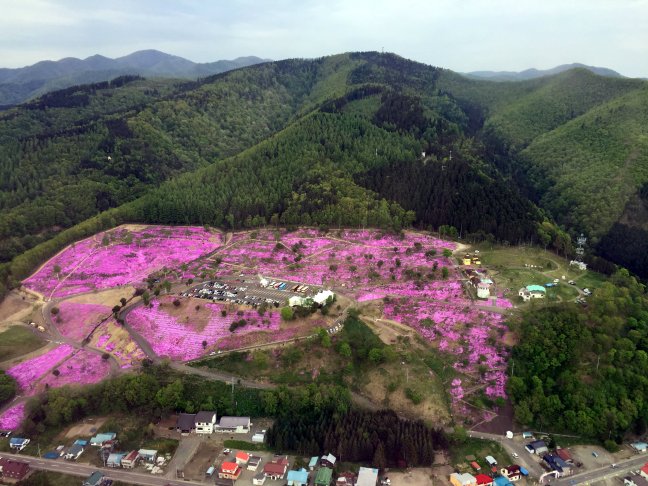Takinoue’s shibazakura park is one of the most famous in Japan, and people come from all over to see it. The creation of the park began back in the Taisho era, with Takinoue’s aspirations to be known as the most flowered city of Japan.
The origins of the park started with a horse shoe maker named Kataoka Heiji. He was originally from Kochi-ken, but with the development happening in Hokkaido he decided to move to Takinoue with his wife. He was initially worried about the move to Hokkaido, but his wife had a fondness for the flowers of Hokkaido. She thought it was a beautiful area, and was looking forward to moving there. So, he agreed to come for her sake, and they moved to Takinoue in the 1920s. With their move, their shared dream of making Takinoue the most famous location for flowers in Japan also was created.
When they arrived, Kataoka intially continued his work with horse shoeing. He and his wife noticed the bad smell of the horse shoeing area, and they decided to plant flowers to mask the smell of it. His wife began to tend to the flowers there, and they often talked about them.
It was in 1919 that the development of what is now the shibazakura park started. In 1922, the townspeople of Takinoue purchased 1,000 sakura trees and planted them on the hillside. Takinoue started to become famous as a sakura-viewing place in Hokkaido. During this time, Kataoka became the caretaker of the sakura trees and the park, a job he took very seriously.
However, in 1938 Kataoka’s wife died. He felt like he hadn’t kept his promise to her about making Takinoue famous Japan-wide for the beautify of its flowers. He was very depressed, and struggled with it until the start of World War 2, during which time he was unable to care for the trees in the park. When the war was finished, Kataoka resumed his care of Takinoue’s flower park. In 1950 Takinoue began to hold an annual sakura festival, and people were coming from far and wide to view the blooming flowers.
There were soon two setbacks that occurred in that time. The first was an abnormally large gypsy moth infestation. They ate many of the plants and trees in Takinoue at that time, and the problem was so serious that soon the town resorted to burning trees in order to kill the moths. With the fires and burning insects, Takinoue began to lose some of its appeal as a fragrant-flower town. During this time is when Asakura Yoshie, another man from Kochi-prefecture, began to work with Kataoka. Together, with Asakura working with the local and Hokkaido goverment, they decided to renew Takinoue’s dream of becoming a flower-town.
In 1954, though, there came the second problem. A terrible typhoon, called the Toyamaru typhoon, hit Hokkaido. This typhoon caused island-wide destruction, and in Takinoue it knocked over about half of the sakura trees in the park. With this, Kataoka and Asakura decided to cease trying to raise sakura trees. They were both discouraged by their setbacks, but when Kataoka thought about his wife he decided to give it another go, and convinced Asakura to keep trying.
During 1956 Kataoka was out and noticed small pink flowers in a nearby garden. He was struck by how vibrant their color was and their beautiful fragrance, and decided that this was how Takinoue would take its place as flower-capital of Japan. Kataoka gathered up wooden orange-box of the flowers, and took them to Asakura to show him what he had found. The flowers couldn’t be killed by the insects or typhoons, so they decided to try it out.
Around this time, Asakura decided to run for mayor of Takinoue and announced his candidacy. Kataoka told Asakura that he would support Asakura in his election if, in return, Asakura would pledge to help him with his creation of Takinoue as a flower-city. Asakura agreed, and went on to win the election and become mayor of Takinoue. He immediately started development on the shibazakura park.
From 1959-1966 Takinoue expanded the area of its park by 5 hectares every year. By this point, Kataoka was getting older, and he died in 1968. Asakura and the townspeople of Takinoue carried on the spirit of Kataoka Heiji by continuing to expand the Takinoue Shibazakura Park, and it eventually reached 7-times the original size. Now, Takinoue has the most vibrantly pink flower garden in all of Japan.






